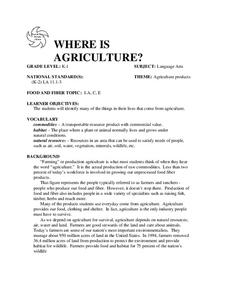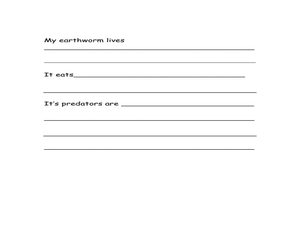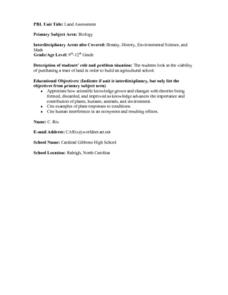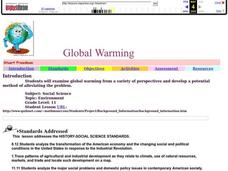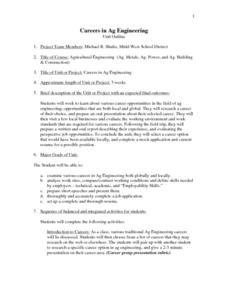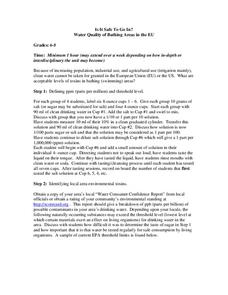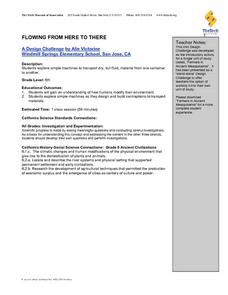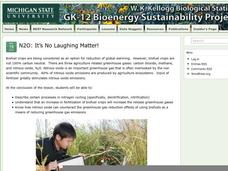Curated OER
Photojournalism: Documenting the Four Greatest Threats to Global Sustainability
Students study global sustainability by viewing photos. For this environment lesson students work in groups and create their own photo gallery.
Curated OER
Plate and Planet
Students investigate the health hazards of modern agriculture and how we can choose better food options. In this healthy eating lesson, students identify different indigenous people in photographs and discuss what they might eat....
Curated OER
Sticks, Stones, Sinews and Stuff: How Early People Used the Environment to Meet Basic Needs
Students create an artifact. For this early survival lesson, students use found objects to create an artifact that could have been used to help early people meet their basic needs.
Curated OER
Environment: Rivers of Destiny
Students investigate the results of human intervention with the Mekong. Mississippi, and Amazon rivers. After watching a video about the status of the three rivers, they complete experiments demonstrating the effects of erosion and...
Curated OER
WHERE IS AGRICULTURE?
The students will identify many of the things in their lives that come from agriculture.See if someone involved in production agriculture will "adopt" your class. Students can correspond with the farmer or rancher's family. This will...
Curated OER
Soil Management
Fourth graders examine different opinions on soil management. In this soil management instructional activity, 4th graders use a variety of resources to research how agriculture and the environment are related. They investigate cause and...
Curated OER
Introduction to Invasive Species
Young scholars explore the environment by identifying invasive species. In this ecosystem observation instructional activity, students identify the native species that exist in an exotic land such as Hawaii and the impact of invasive...
Curated OER
Earthworms and Making a Wormery
Students explore the environment by researching insects. In this earthworm lesson, students utilize soil and plexiglass to build a see through wormery in which students can observe the worms at work. Students identify the benefits of...
Curated OER
Who's Who?
Students explore biology by identifying animals and their environments. In this animal characteristic lesson, students read assigned text about farm animals, how they are raised, and what they are used for in our society. Students view a...
Curated OER
Land Assessment
Students work in small groups on a problem based learning activity. Students are presented with a problem of buying land to use for educational purposes only and must determine if it is feasible to buy it based on soil analysis and plant...
Curated OER
Global Warming
A series of independent learning activities teaches learners about global warming as it relates to economics and industrialization. The culminating project requires them to create a multimedia presentation identifying the problems,...
Curated OER
Careers in Ag Engineering
Students examine various careers in Ag Engineering both globally and locally. They analyze work sites, compare/contrast working conditions and define skills needed by employers. They prepare short speeches and present them, accurately...
Agriculture in the Classroom
Growing a Nation: Into a New Millennium 1970-Present
If you want to focus on critical thinking skills, this well-constructed series of activities will challenge your history or agriculture class to evaluate the effectiveness of administrative decisions related to agricultural and the...
One Hen
Making Choices
When choosing what foods to eat, there are a lot of factors to consider. To help make the decision a little easier, young learners work in small groups developing short plays, stories, or advertisements that address the different issues...
Curated OER
The Land and People Before Columbus
The major pre-Columbian settlements are studied in this excellente social studies lesson. Fifth graders explain how geography and climate influenced the way various nations lived and adjusted to the environment, and focus on eight...
Curated OER
Is It Safe to Go In? Water Quality of Bathing Areas in the EU
Using your senses, apprehend the effects of contaminants in water. With a global focus, young scientists conduct a safe experiment by tasting sugar and salt water with different dilutions. After reviewing threshold limits, learners write...
National Wildlife Federation
Quantifying Land Changes Over Time in Areas of Deforestation and Urbanization
Is qualitative or quantitative research more convincing when it comes to climate change? In the eighth lesson during this 21-part series, scholars begin by performing a quantitative analysis of deforestation and urbanization. Then, they...
Curated OER
Scarcity of Land Throughout the World and in Hawaii
Students discuss the importance of "land." They review the four types of land classification--urban, rural, agricultural and conservation--and participate in an activity involving an apple that demonstrates the use of land in Hawaii....
Curated OER
Prairie Scavenger Hunt
Here is a simple lesson for young learners on the plants, animals, and flowers found in the prairie environment. There are worksheets embedded in the plan that pupils use once a teacher-led discussion and demonstration has taken place....
Curated OER
Flowing From Here to There
Sixth graders discover how humans modify their environment. They work together to design their own simple machine to transport materials. They record observations and suggest modifications.
WK Kellogg Biological Station
N2O: It’s No Laughing Matter!
While the layout of the lesson is not very detailed and the link to the PowerPoint is no longer valid, there are some great exercises to examine the role of nitrous oxide in the environment. For middle level learners, the resource listed...
Curated OER
This Is Tanzania
Students study the volcanic history and the wildlife of Tanzania. They examine how most Tanzanians live on a subsistence agricultural economy.
Curated OER
Stopping Deforestation in the Amazon: A Publicity Campaign
Young scholars investigate the environment by designing a group project. In this ecology lesson, students identify the man made threats to the Amazon while reading environmentally conscience vocabulary terms. Young scholars...




